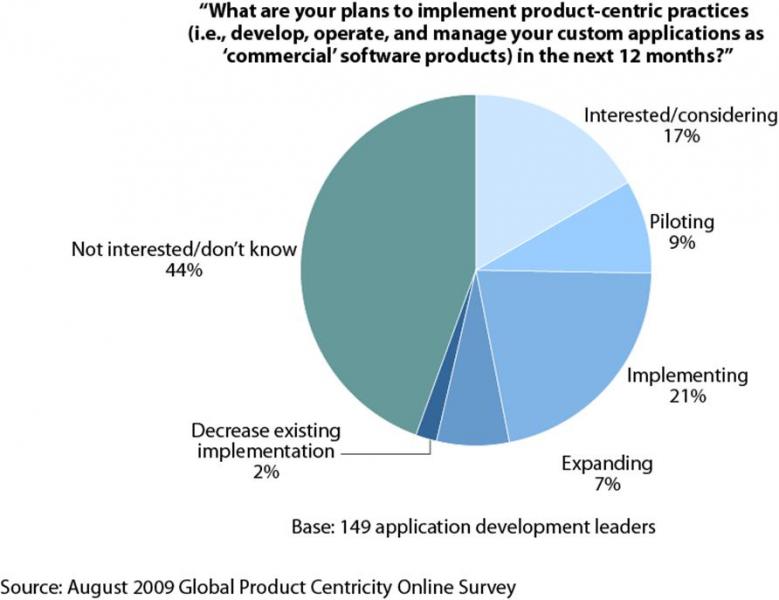Should You Be Running Your Software Organization Like A Business That Delivers Products?
Is it hard to focus your software delivery organization on the right things? Do you sometimes deliver the wrong features or give too little priority to the most important features? Are you drowning in the cost of too much redundant software, because stakeholders can’t get on one page about what the business really needs? Do you struggle to make the case for investments you know are essential to your long-term survival but that deliver few short-term benefits? If so, consider the benefits of running your shop more like a business by reorganizing to deliver products (or value streams, in Lean lingo).
It’s been more than two years since we last surveyed software delivery leaders about their increasing tendency to organize to deliver software as products (rather than projects or application functional areas), but even then this trend was well under way:

I have only anecdotal evidence that this trend is continuing to grow, but I’m convinced by hundreds of interactions with top software delivery leaders since we did this survey that it is, especially for people who deliver customer-facing websites and mobile apps. Customer-facing dynamics are also driving this trend for the “Internet of things” among firms focused on Smart Grid and other similar domains that depend on customer adoption to drive success. What are the factors driving this growth?
- The age of the customer, mobile apps, and the growth of more digital experiences. We see strong growth in firms transforming their software delivery capabilities to enable them to succeed in the age of the customer. This requires reskilling and reorganizing to rapidly deliver customer-facing web and mobile capabilities, with a strong focus on design, customer experience, agile delivery, the “lean startup” model (e.g. evolving minimally viable products – MVPs – into category winners), and leveraging the cloud for faster time-to-market and elastic growth potential.
- The trend to the open Web. I was in Austin for South by Southwest Interactive last month, and the trend to delivering products through a web API platform was in full flower. And it’s no longer just fashionistas of the web and mobile world doing it; there were many large enterprises represented in sessions about how to build a business around the APIs you deliver. Not all APIs are a product, but for those that are, this organizational approach makes total sense.
- Increasing tension between the new way and the old way. The old way is budgeting and planning large projects way in advance and then hoping things turn out that way. The new way is investing in a product portfolio and managing the flow of that investment through an Agile backlog of features, releasing MVPs and incrementally growing them. But in an organization that has both going on, it creates huge tension between the people pursuing the new way and the people (like the CFO or operations) who are clinging to the old way because it’s the only way they know to manage risk. They have to learn the new way, and you have to teach them.
So if you’re feeling the effects of these forces at work on your business and you have the symptoms I mentioned at the start of this post, you should seriously consider reorganizing in this way. Forrester can help you figure this out: we’ve been delivering workshops for clients to help them understand how the model works and how to apply it in your firm. If you’re a Forrester client, just submit an inquiry in the normal way, and ask for me – I’ll connect you with the right people on our team. I’ll also be posting more of the insights we’ve gained into the benefits of the product-centric approach in the near future.
But even if you don’t ask for our help, if this post resonates with you, it’s time to get product-centric!